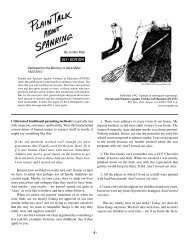By Jordan Riak - Project NoSpank
By Jordan Riak - Project NoSpank
By Jordan Riak - Project NoSpank
You also want an ePaper? Increase the reach of your titles
YUMPU automatically turns print PDFs into web optimized ePapers that Google loves.
Neglect and permissiveness .<br />
Defenders of spanking often argue that a caretaker’s only choice is between<br />
spanking and doing nothing. That’s a false choice. Permissiveness is as unwise<br />
and counterproductive as hitting. The wise caretaker establishes a safe<br />
environment with age-appropriate boundaries and reasonable rules, models<br />
called-for behaviors, and appeals to and cultivates the child’s natural inclination<br />
toward imitation and cooperation. This method takes more skill and patience<br />
than hitting, but it works. It strengthens the bond of trust between parent and<br />
child, between teacher and learner, thus paving the way for the many<br />
challenging lessons ahead.<br />
Spousal battery and spanking .<br />
In the overwhelming majority of cases, husbands and wives whose relationships<br />
include violence are also violent toward their children. Such people surely<br />
were spanked when they were little and likely witnessed others being spanked.<br />
Battering and battered spouses who spank their children are raising them<br />
to become batterers and victims exactly like themselves. The children learn<br />
from the parents’ example that the way to vent frustration, express disapproval<br />
and assert authority is by hitting someone smaller and weaker than themselves.<br />
They see this principle demonstrated every time they witness their parents<br />
come to blows, as well as every time they are on the receiving end of violent<br />
punishments. They learn that once they are big enough and strong enough,<br />
they can control others by threatening or hurting them. They learn that it is<br />
okay for husbands and wives to mistreat each other and for adults to<br />
mistreat children. ..<br />
When children, whose personalities have been formed in violent households,<br />
grow up and have children of their own, they find it very difficult to break<br />
free from the behaviors they have witnessed and experienced. The skills<br />
they apply to family life will be the poor ones they learned from their parents,<br />
and they are likely to perpetuate the cycle of abuse through their own<br />
innocent children. ..<br />
As spanking disappears from family life, other forms of domestic<br />
violence will also disappear. .<br />
standard ethics for certain sets of people?”<br />
Adah Maurer, “Psychodynamics of the Punisher,” Watman<br />
Educational Services, 1974. See www.nospank.net/maurer2.htm. .<br />
“Punitive measures whether administered by police, teachers, spouses or<br />
parents have well-known standard effects: (1) escape—education has its<br />
own name for that: truancy, (2) counterattack—vandalism on schools and<br />
attacks on teachers, (3) apathy—a sullen do-nothing withdrawal. The more<br />
violent the punishment, the more serious the by-products.” .<br />
B. F. Skinner, Ph.D., author, Professor of Psychology, Harvard<br />
Excerpt from personal communication,1983. .<br />
“Corporal punishment trains children to accept and tolerate aggression. It<br />
always figures prominently in the roots of adolescent and adult aggressiveness,<br />
especially in those manifestations that take an antisocial form such as<br />
delinquency and criminality.” .<br />
Philip Greven, Professor of History, Rutgers University. Excerpt<br />
from Spare the Child: The Religious Roots of Punishment and the<br />
Psychological Impact of Physical Abuse, 1990. (p.193) See<br />
www.nospank.net/greven.htm.<br />
“I have always been an advocate for the total abolition of corporal<br />
punishment and I believe the connection with pornography that is so<br />
oriented has its roots in our tradition of beating children.”<br />
Gordon Moyes, D. D., Pastor, Uniting Church, Superintendent of the<br />
Wesley Central Mission, Sydney, Australia. Excerpt from personal<br />
communication,1980. .<br />
“The much-touted ‘biblical argument’ in support of corporal punishment is<br />
founded upon proof-texting a few isolated passages from Proverbs. Using<br />
the same method of selective scripture reading, one could also cite the Bible<br />
as an authority for the practice of slavery, adultery, polygamy, incest,<br />
suppression of women, executing people who eat pork, and infanticide. The<br />
Escalation .<br />
brutal and vindictive practice of corporal punishment cannot be reconciled<br />
Physical injuries and deaths of children caused by their caretakers often are<br />
with the major New Testament themes that teach love and forgiveness and a<br />
the consequence of physical punishment. Perpetrators of even the most<br />
respect for the sacredness and dignity of children—and which overwhelmingly<br />
horrendous acts against children typically explain that the child’s misbehavior<br />
reject violence and retribution as a means of solving human problems. Would<br />
called for punishment, and the outcome was unintended. “Accidental” is the<br />
Jesus ever hit a child? NEVER!”<br />
child abuser’s all-weather alibi.<br />
The Rev. Thomas E. Sagendorf, United Methodist Clergy (Retired),<br />
.<br />
Hamilton, Indiana. Personal communication, 2006. .<br />
4 13





